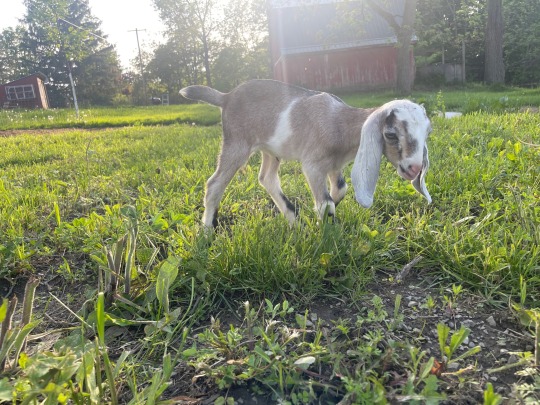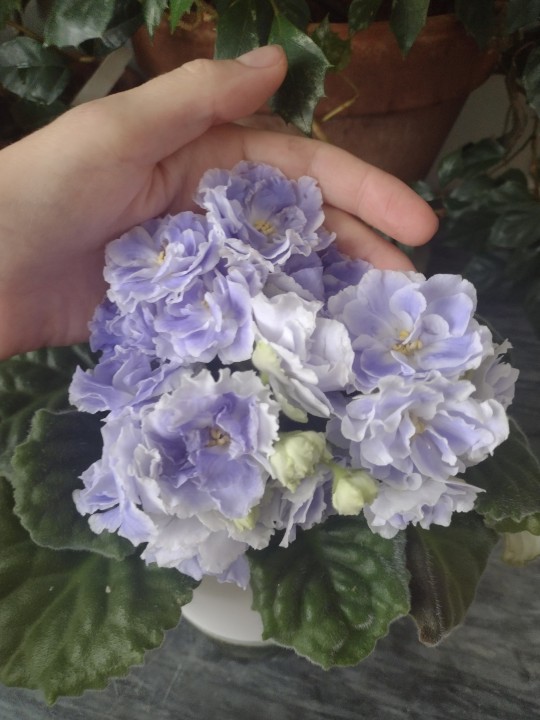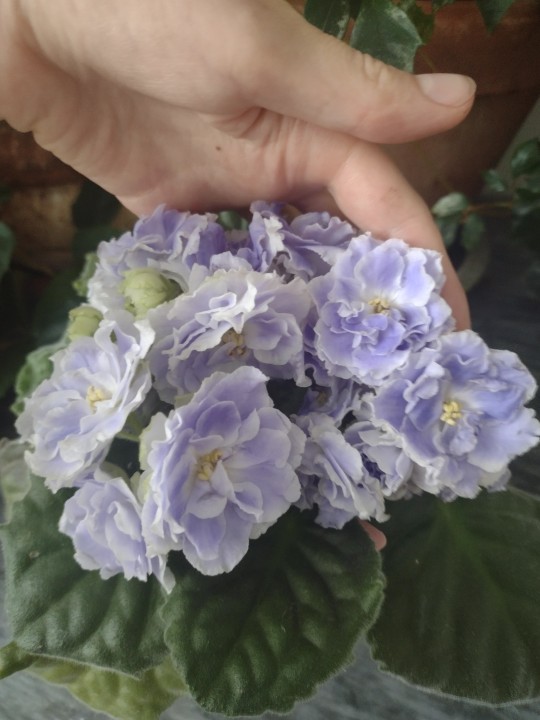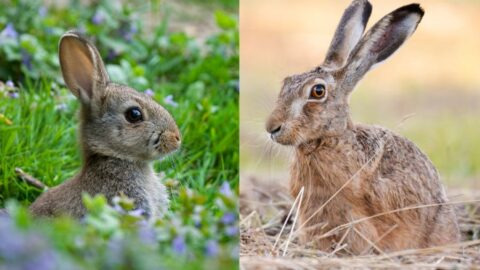#disbudding
Explore tagged Tumblr posts
Text

Young cow skull. I believe the dark marks on the horn remnants are from disbudding.
169 notes
·
View notes
Text

i think she forgives me
#goats#kids#daphni#we had our No Good Very Bad Day (disbudding) and i always worry they'll hate me after#but they never seem that bothered by it after it's done#a little head shaking and a big nap and they're pretty ok#i need to get up and keep working but how can i????
35 notes
·
View notes
Text


Precious little Agnes
19 notes
·
View notes
Text


RS Aquamarine is still blooming nonstop. It's really unusual to have a violent with blooms this big that also puts out huge clusters of buds and has individual flowers that last a long time. I think it is my favorite violet. I'd better root myself a second because if something happens to it I'm going to be heartbroken. The phone camera isn't doing the colors justice. In real life it's sky blue, not light purple.
#african violet#houseplant#saintpaulia#flowers#gesneriads#i also make about $10 a month from this by selling leaf pairs#which is further incetive to root another one because there's only so many leaves i can take from one plant#this plant is really something because normally I'd have to disbud to get leaves to grow back fast but with this one it's not necessary
21 notes
·
View notes
Text
Kejati Menggeledah Kantor Dinas Kebudayaan Jakarta, Ratusan Stempel Palsu Disita
Jakarta, Cinews.id – Kejaksaan Tinggi (Kejati) Daerah Khusus Jakarta (DKJ) melakukan penggeledahan di Kantor Dinas Kebudayaan DKJ terkait penyidikan kasus dugaan korupsi penyimpangan kegiatan-kegiatan pada Dinas Kebudayaan Provinsi DKJ ini. Dalam penggeledahan itu, penyidik menyita beberapa unit laptop, handphone, PC, dan flashdisk yang bakal dianalisis forensik. Selain itu, ada pula uang tunai,…
0 notes
Text
The Intriguing Universe of Disbuds Flowers: Their Nature and Reasons for Popularity
If you enjoy gardening or flowers, you've probably heard the phrase "disbuds flowers" about several flower types. A popular horticultural method for improving the size, shape, and quality of flowers is disbudding. Although chrysanthemums are frequently linked to this technique, it may be used on a wide range of other plants. Gaining a grasp of disbuds can help you cultivate flowers more successfully, regardless of your degree of experience.

Explore Melbourne's Blooming Delight: Armadale Flowers' Magnificence
Located in the inner suburbs of Melbourne, Armadale flowers is a charming neighbourhood renowned for its beautiful gardens, green lanes, and sophisticated architecture. Whether you're a visitor or a native, Armadale's gardens and flowers provide an enthralling look into Melbourne's passion for the outdoors and the natural world.
The neighbourhood of Armadale skilfully combines urban life with scenic surroundings. This area has a calm environment since many of the residences are surrounded by well-kept lawns and private gardens. A vast range of flowers may flourish in the region's Mediterranean climate, which has hot, dry summers and moderate winters.
The method enhances the blooms' general quality and vitality. By reducing congestion, disbudding makes sure that every bloom has the room and nutrients to develop to its maximum potential. Stronger, more colourful petals and a sturdier stem that can hold up the bigger bloom are the results of this.
Armadale Flowers: A Charming and Colourful Neighbourhood
In the neighbourhood of Armadale, urban living and environment coexist together. It is no surprise that the region is well-known for its exquisite flowers given its magnificent gardens and colourful floral arrangements. Armadale flowers provide vitality and beauty to this quaint Melbourne neighbourhood, whether you're taking in the roses on a beautiful afternoon stroll, purchasing fresh flowers from a nearby florist, or going to a garden event.
From lively garden markets to neighbourhood flower shops, Armadale has a wide range of alternatives to choose from if you want to incorporate some of this floral beauty into your own house or garden. Accept the hues, fragrances, and designs of Armadale's flowers and allow them to serve as inspiration for your floral explorations.
Source
0 notes
Text
Writing Notes: Dahlias

Dahlia - tuberous plant native to Central America and Mexico.
Dahlia flowers come in a range of colors and sizes, including the popular waterlily, collarette, pompon, peony, and cactus dahlia varieties.
Smaller bedding dahlias have flowers that are only a few inches wide, while taller dinner plate dahlias can grow blooms up to 15 inches in diameter.
Though dahlias are a perennial plant, they can only survive the winter in USDA hardiness zones 8 to 11, and gardeners often grow them as annuals in other climate zones.
How to Plant Dahlias
Planting dahlias is a straightforward process as long as you follow the proper guidelines.
Choose healthy dahlia tubers. When buying dahlia tubers at your local garden center, look for ones with pink buds and a tiny bit of green growth, and avoid any with a wrinkled appearance.
Plant dahlia tubers in late spring. Dahlias flounder in cold weather and require a ground temperature of at least 60 degrees Fahrenheit, so make sure you plant them outdoors after the last frost date. You can also start dahlias indoors four to six weeks before the last frost and then transplant them outside. If starting dahlias indoors in a container, plant dahlia tubers two inches deep in a soilless potting mix, and wait until you see new growth before you water.
Choose a sunny location with wind protection. In most climates, dahlias thrive in full sun conditions and require six to eight hours of direct sunlight. In hotter climates (USDA hardiness zones 8 to 11), it's best to give dahlias some afternoon shade to keep them from getting overheated during the hottest part of the day.
Plant dahlias in rich, well-drained soil. Dahlias grow best in slightly acidic soil with a pH between 6.5 to 7.0. If your soil is high in clay content, try working in some peat moss or sand to loosen it up and provide better drainage. You can also use bone meal to add nutrients to the soil.
Give dahlia plants plenty of space. Plant smaller bedding dahlias eight to 12 inches apart. Larger dinner plate dahlia varieties may need two to three feet of space.
Bury dahlia tubers in stages. Dig a hole about eight inches deep and slightly larger than the dahlia bulb's root ball. Place the bulb inside with its eyes (buds) facing upwards, and cover it with about two inches of soil; once it begins to sprout, fill the rest of the hole.
Stake taller dahlia cultivars. Staking taller dahlia varieties (three feet or larger) may be necessary to provide support. Use wooden or metal stakes that are at least five feet tall, or place a tomato cage over each plant.
Wait to water until the dahlias have sprouted. Watering immediately after planting may cause tuber rot, so wait until sprouts have breached the topsoil before watering. Avoid mulching unless you're planting in a particularly hot climate.
How to Grow and Care for Dahlias
Dahlias have a bloom time from late summer through the first frost in the fall. In order to grow healthy dahlias that bloom all season long, follow these growing tips.
Water dahlia plants deeply once they’re established. It's better to water your dahlia plants thoroughly once or twice a week throughout the growing season than to give them a light watering every day. Dahlia plants in hotter climates require slightly more water but avoid over-saturating your soil to prevent rotting tubers.
Feed dahlias with a low-nitrogen fertilizer. Using a low-nitrogen liquid fertilizer approximately every four weeks after your dahlias sprout can lead to larger, more beautiful blooms.
Practice deadheading and disbudding. Make sure to remove dead flower heads to keep your dahlia flowers blooming longer. To produce extra-large flowers, try disbudding: Remove the smaller flower buds in each cluster so your plant can put additional energy into growing the central bud. To produce bushier dahlia plants, once they grow about one foot tall, pinch off the top of each center stalk to promote outward growth.
Monitor your dahlias for diseases. Dahlias are prone to contracting powdery mildew, which is often the product of wet leaves and poor air circulation. Water from below to keep your dahlia leaves dry. If you do spot powdery mildew, treat the disease using an appropriate fungicide. Dahlias may develop stem rot in poorly drained, waterlogged soil, so make sure not to overwater.
Keep pests under control. Aphids, caterpillars, earwigs, slugs, and spider mites all commonly plague dahlia plants. Spray away aphids with a stream of water from a garden hose, handpick any caterpillars off the leaves, use slug bait to control slugs and earwigs, and spray leaves with neem oil to take care of spider mites.
Source �� More: Notes & References ⚜ Writing Resources PDFs
#dahlia#flowers#nature#writing notes#writeblr#worldbuilding#writing inspiration#writing ideas#light academia#writers on tumblr#writing reference#literature#spilled ink#dark academia#writing prompt#creative writing#berthe morisot#writing resources
57 notes
·
View notes
Text

Disbudding baby pansies this time of year makes for pretty trash
61 notes
·
View notes
Text

Disbuds for Nicky [a commissioned drawing for her new house]
29 notes
·
View notes
Text

Fat Nuggets Redesign! (1/???)
Very quick post for today because it is my birthday! I wanted to draw a character that I actually enjoy and genuinely have like no issues with because he is just a pig. I plan to draw some other pets like Vark but that’ll be more complex and about Vox because Vark will be a seizure alert animal and I want to put a lot of stuff into that post. Fat Nuggets though he’s just. God he looks so stupid. I love this pig man. Fat Nuggets is not a minipig in my rewrite by the way! He is a hellhog piglet and is at least 11 years old, however hellhogs age very very slow and he will not be big for a long while.
Considering he was also previously raised in a bad environment and was in someone else’s possession prior to Angel who did not treat him well at all, there are some things Fat Nuggets cannot do or experience. After his previous owner tried to disbud him for “less hassle”, it has permanently stunted and damaged his horns and spikes so they can no longer grow any longer than they are now. Fat Nuggets is now being well cared for and has not had any unwilling cosmetic procedures performed on him, is happy and healthy, and enjoys eating oatmeal.
If Angel actually signed him up for it I have no doubt he could become a therapy animal. Honestly I may look into the idea, I think a lot of these guys could benefit from a warm pig on their lap. Oh also, reminds me, because Angel is cold-blooded (technically) Fat Nuggets is his main source of warmth whenever clothes or blankets aren���t available or working well. Very good pig!
#hazbin hotel#hazbin critical#hazbin hotel criticism#hazbin hotel critical#angel dust#hazbin angel dust#anti vivziepop#hazbin angel#angel dust hazbin#angel dust hazbin hotel#hazbin fat nuggets#fat nuggets hazbin#fat nuggets hazbin hotel#fat nuggets#angel dust and fat nuggets#hazbin hotel fat nuggets#my art#hazbin hotel rework#hazbin hotel rewrite#hazbin hotel redesign#hazbin rework#hazbin redesign#hazbin rewrite
91 notes
·
View notes
Text
Read my latest blog on pain relief for castrating male kids with rubber rings or disbudding kids.
28 notes
·
View notes
Text
Disbudded agnes myself! Yayyy! Aaaand banded the two bucks :•)
#goats#my skills im so useful 🧡#i still make my mom do vaccines thoughhhhh sorry#she hates disbudding so it works out well
3 notes
·
View notes
Text
Lets Talk Farm Terminology!
Yay! I'm here to answer all the simple farm animal questions and misconceptions you've been too afraid to ask! Why? Because im bored and have thoughts and am reading Watership Down and want people to know the difference between "bunny," "rabbit," and "hare."
Leporidae

You're probably thinking wow kes how bold of you to start out not only with an animal uncommonly kept by farmers but also starting with a scientific name few will know! And you're right, but I don't care! The Leporidae family includes rabbits and hares, and yes! they are different. Very closely related as they belong to the same family, but rabbits and hares are not the same thing. Simply: hares are bigger and wilder than rabbits. There are no domestic species of hare and they are more adapted to solitary life than living in groups/colonies. Looking at the image above you can note slight differences in facial structure and build, as well as most notably the ear length, with the smaller rabbit on the left and the larger hare on the right. Most Watership Down art features hares but I don't mind it all that much as the hare anatomy is more fun lol.
Now, what's a bunny? Bunny is an informal term used to refer to rabbits, especially young ones. It wouldn't be incorrect to refer to the long eared friend in your yard as a bunny but if you were writing a paper or just want to sound more serious, it would be better to say rabbit (as you notice, I am refraining from calling them bunnies in this post).
When referring to rabbits, their terminology is similar to other familiar animals. A male rabbit is called a buck and a female rabbit is called a doe, like deer or goats. However, a baby rabbit is called a kit or kitten and a group of siblings is called a litter, just like cats.
Goats

Aw no more latin? As the domestic breeds of goat all come from the same species, there's no need for a broad scientific name as we all have an idea of what to picture, unless you're thinking of a mountain goat which are not considered true goats and are considered a goat-antelopes, making them closer in relation to muskoxen! Which is a whole different topic! Regardless, there's lots of different breeds of domestic goats (Capra hircus), like dogs and cats. Some are better suited for dairy production, some for meat, others are bred for their cashmere! Pictured above is a Saanen goat, one of, if not the most popular dairy goat breeds (in the US at least), known for their high milk production.
Many goat breeds have horns, which vary from antlers bc of how they grow and their composition. Horns can be removed when the goats are young, in a process called dehorning or disbudding. When horns are removed, their growth is stunted and they will not grow back once the animal is older. However, disbudding is a controversial topic as it is not painless and often unnecessary. Both male and female goats can have horns, although their appearance may differ.
I mentioned above that (mature, uncastrated) male goats are called bucks and females are called does. Many, many people use the terms billy and nanny to refer to goats. However, the better term would be buck/doe, and when people use billy/nanny it does peeve me. You may also hear the word wether to refer to castrated goats. Baby goats are called kids.
Cattle

My favorites of the post, let's finish with cattle (Bos taurus)! Same as goats, cattle can be bred and used for many purposes like the lovely Brahman I've included above, a very recognizable meat breed. Cattle terminology can get a little tricky as its not as straightforward as some other animals.
Cattle is the correct term for these animals, as cow technically refers to a mature female (has been bred). No one's going to freak out if you say cows instead of cattle, myself included, especially because if you dont know the specific details of the animal its hard to know whether to say cow or heifer or bull or steer.
So, a cow is a mature female, and a mature male is called a bull. An immature, young female is called a heifer. A castrated male is called a steer. When referring to an immature male you can use bull or bull calf.
Many places you will see the term "ox" thrown around (not to be confused with a MUSKox mentioned previously) and there's a lot of misconceptions surrounding the name. An ox is a specially trained bovine. That's all it is. There's lots of regulations on how they are trained and all that, but that's the basics of it. It is most common and recommended to use castrated males (steers) because castration should temper their aggression and testosterone production; additionally, males are typically larger than the females. However! Female cows can be trained as oxen, as can bulls.
Technically an ox should not be referred to as such until they have completed their training, which can take years. Typically oxen are selected at a young age and routinely worked to develop good skills. They are used for tasks plowing or pulling carts, and as modern technology has improved, use of oxen has declined.

Thaaaat's all I have to say about that today, I sort of led into each topic in little ways and I've nothing more to mention. Hopefully you learned a little, I think livestock are cool 👍
#why did you write this you ask#well i am full of anxiety and talking about things i confidently know about is a good distraction#kestrel calls#chitter chatter#desc in alt#yell at me (nicely) if im wrong!#ask questions if you have any confusions!#i work with kids so nothing is adumb question
12 notes
·
View notes
Note
The horns got me curious about how one would manage them, so I looked some stuff up and I got bad news (don’t look any further unless you’re willing to accept your dreams of adorable part-goat children with pool noodles on their horns being destroyed, and also some vague descriptions of the potential side-effects of having horns. Theresa a TL;DR at the end if you want to skip the very unwholesome details, while also leaving you on a far more wholesome note):
As it turns out, unless they’re using their horns for self-defense (not very useful if you already have opposable thumbs) or heat regulation (which wouldn’t be necessary in this case, as the kid’s part-human nature means she probably already regulates temperature very efficiently via sweating, and even most actual goats don’t have dense enough fur for overheating to be an issue outside of environments that even normal humans would consider worryingly hot) there is literally no good reason for a goat to have horns. Because as it turns out, while incidents such as accidentally breaking your own neck after getting your horns stuck in a fence aren’t much of an issue for something with human intelligence, unless trimmed regularly (which can be incredibly painful unless done very carefully and skillfully) horns can still grow around and eventually circle back into the animal’s own skull!
The humane thing to do is to burn to death the tissue that would otherwise eventually grow into the horn. It’s fairly painful for the kid, since it’s usually done as soon as kid has developed enough for one to tell where the tissue is so as to be sure the tissue is killed before the horn can start to grow, meaning that the kid is usually too young to safely take very strong anesthetics (AFAIK, at least—I’m neither a veterinarian nor a farmer).
However, although ‘disbudding’ (as the process is called) can be quite painful, ‘dehorning’ (which is required if the horn has already formed), while more likely to occur at an age when the kid can safely take very strong anesthetics, is also far more risky. This is because dehorning both requires a specially trained veterinarian and is far less reliable than disbudding even when done by such a professional, as there’s always the risk that the horn will just grow back anyways—except now they’re deformed and far more immediately threatening.
TL;DR: On the human body (or even on most domesticated goats) horns lose all the advantages they give to wild goats while still retaining some major risks, so you want to do everything you can to keep the horns from developing in the first place—otherwise they’ll end up having to deal with the risky and nail-biting process of carefully shaving down those horns down to just before the horn’s very sensitive bony core every few months, like Ganyu presumably has had to do hundreds of times throughout her very long life. On the upside, at least horn shaving is a good bonding experience with Ganyu, kinda like how getting a shave means trusting somebody enough to let them put an extremely sharp blade directly against your throat without fear of harm, accidental or not.
Well, as terrifying as this all seems, horns growing close to the goat’s eyes can be fixed by the occasional trimming with a saw wire. When the horn grows too close to the eye, I believe people use a saw wire to cut off the tip, but not deep enough where it would hit a nerve/blood vessel. I don’t think it hurts when you trim it just at the tip, but the goats do feel a big vibration through their horns :0
I’m no sheep/goat expert though, just a city girl who watched a few goat trimming videos before lol. Either way, I don’t think Ganyu’s baby would have their horns grow too close to their face. Ganyu is more than capable of taking care of their horns (this includes shaving it when needed) and making sure they don’t grow too long in the first place :)
#🫧feeding the fishes#also the fact that baby goat is well—#part human lol#they aren’t as helpless as real goats
40 notes
·
View notes
Text
Unveiling Disbuds Flower: A Journey Through Floral Splendour
Disbuds flower have a longer vase life than many other cut flowers, which makes them a perfect choice for arrangements of flowers in homes, occurrences, and businesses around Melbourne. Their enormous, single blooms with a disc at the centre make them suitable for a variety of floral creations, from exquisite bouquets to elaborate centrepieces, which enhance the look of any environment. Disbuds are available in a variety of colours, allowing for creative flower arrangements and allowing painters in Melbourne to integrate them with various themes, seasons, or colour palettes.

A Wide Selection of Choices with Round-the-Clock Care
With online flower delivery in Altona, you can easily examine and buy your selected blooms by scrolling down the e-commerce website. Physical flower businesses may offer restricted flower alternatives based on the time of year and type of flowers ordered by the florist. With the help of emergency floral delivery services, you can make up for any occasion that you seem to have forgotten.
Flower delivery companies can readily locate the specific bloom species that your partner likes. In addition, the customer care representative may assist you in creating a lovely note to accompany your gift box. Some flower businesses charge a premium for specialised services like rapid flower delivery and same-day delivery.
Assurance of Quality with Experienced Design for Specialised Occasions
Reputable flower delivery businesses in Altona prioritise product quality and freshness. They pick flowers from reputable vendors to ensure that each arrangement is constructed with the freshest flowers available and retains its beauty for as many days as possible.
Florists who specialise in flower delivery in Altona are knowledgeable in floral design and presentation techniques. They may produce gorgeous bouquets and presentations that express the intended message or feeling, such as love, sympathy, admiration, or appreciation. They provide themed arrangements and customisations to match the mood and purpose of each occasion.
Source
0 notes
Text
The last living elders are the only ones where you can see that these fairies would actually have horns if they were left to grow. The younger generations are all disbudded as infants for certain practicality reasons.

#art#artists on tumblr#drawing#fantasy#fantasy art#oc#webcomic#original character#worldbuilding#scifi art#digital art#sketch
8 notes
·
View notes